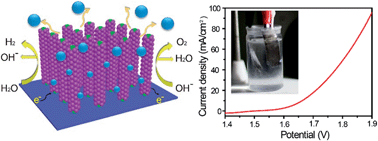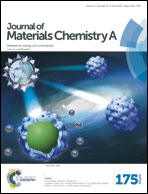Myriophyllum-like hierarchical TiN@Ni3N nanowire arrays for bifunctional water splitting catalysts†
Abstract
Inspired by Myriophyllum, a natural plant, we report an efficient electrochemical water splitting device based on hierarchical TiN@Ni3N nanowire arrays. The bifunctional TiN@Ni3N nanowire arrays serve as both hydrogen evolution reaction (HER) and oxygen reaction evolution (OER) catalysts in this device. As a hydrogen evolution catalyst, the TiN@Ni3N nanowire arrays possess an onset overpotential of 15 mV vs. the reversible hydrogen electrode (RHE), a Tafel slope of 42.1 mV dec−1, and an excellent stability of <13% degradation after being operated for 10 h, much better than Pt disks and Ni3N nanosheets in alkaline electrolytes. For oxygen evolution performance, the Myriophyllum-like TiN@Ni3N nanowire arrays exhibit an onset potential of 1.52 V vs. RHE, and a high stability of 72.1% current retention after being measured for 16 h in the potentiostatic mode. Furthermore, a symmetric electrochemical water splitting device was assembled by using the Myriophyllum-like TiN@Ni3N nanowire arrays as two electrodes, possessing a water splitting onset of ∼1.57 V with a current retention of 63.8% after 16 h of operation.


 Please wait while we load your content...
Please wait while we load your content...